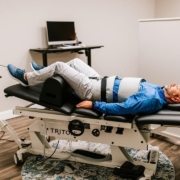Aligning Your New Year Goals with Chiropractic Care for a Healthier You
As we usher in the New Year, it’s a time for reflection, resolutions, and setting goals for the months ahead. While many people focus on health and wellness resolutions, one aspect that often gets overlooked is the role of chiropractic care in achieving these goals. In this blog post, we’ll explore the connection between New Year goals and chiropractic care, highlighting how spinal health can play a pivotal role in your overall well-being.
Prioritizing Health and Wellness Goals:
The start of the year is the perfect time to commit to a healthier lifestyle. Whether your goals involve losing weight, exercising more, or adopting better dietary habits, chiropractic care can complement these efforts by addressing the core of your physical health – your spine. A properly aligned spine can contribute to improved nervous system function, leading to better overall health and vitality.
Pain Management and Increased Mobility:
If you’ve set fitness goals for the New Year, you’re likely to encounter sore muscles and joint stiffness along the way. Chiropractic adjustments can aid in pain management by ensuring that your spine is aligned correctly, reducing tension in the muscles and promoting better joint mobility. This, in turn, can enhance your ability to engage in physical activities and reach your fitness milestones.
Stress Reduction for a Balanced Life:
Many individuals set resolutions related to stress reduction and achieving a more balanced life. Chiropractic care not only addresses physical symptoms but also promotes mental well-being. By optimizing spinal alignment, chiropractors can help alleviate stress and tension, allowing you to approach your goals with a clearer mind and a more positive outlook.
Improved Sleep Quality:
Quality sleep is crucial for overall health and well-being. If your New Year goals include getting better sleep, chiropractic care may be a valuable addition to your routine. Proper spinal alignment can positively impact your nervous system, leading to improved sleep patterns and a more restful night’s sleep.
Enhancing Mind-Body Connection:
Chiropractic care is not just about physical adjustments; it also emphasizes the mind-body connection. Many individuals set goals related to mindfulness, meditation, or yoga to promote mental clarity and emotional well-being. A well-aligned spine contributes to a balanced nervous system, fostering a deeper mind-body connection and supporting your journey towards holistic wellness.
Conclusion:
As you embark on your New Year journey towards health and wellness, consider integrating chiropractic care into your routine. The benefits extend beyond addressing specific physical issues to promoting overall well-being and aligning with your broader goals. By taking care of your spine, you’re investing in the foundation of your health, allowing you to pursue your resolutions with a body that is in harmony and balance. Make chiropractic care a key component of your New Year’s commitment to a healthier and happier you.










